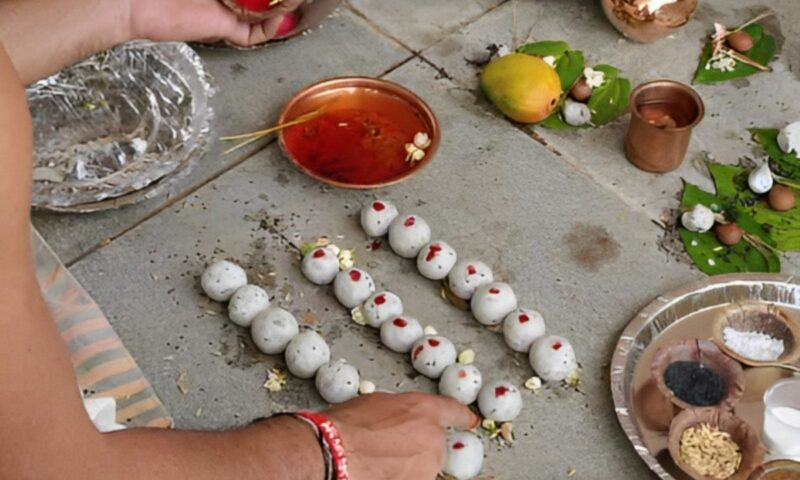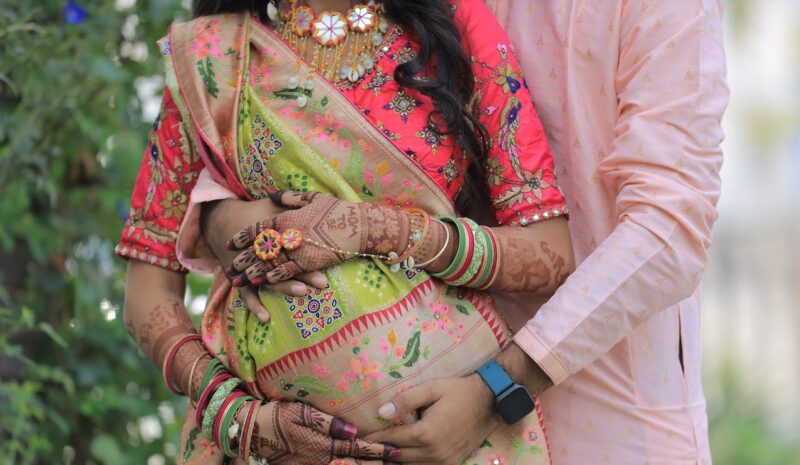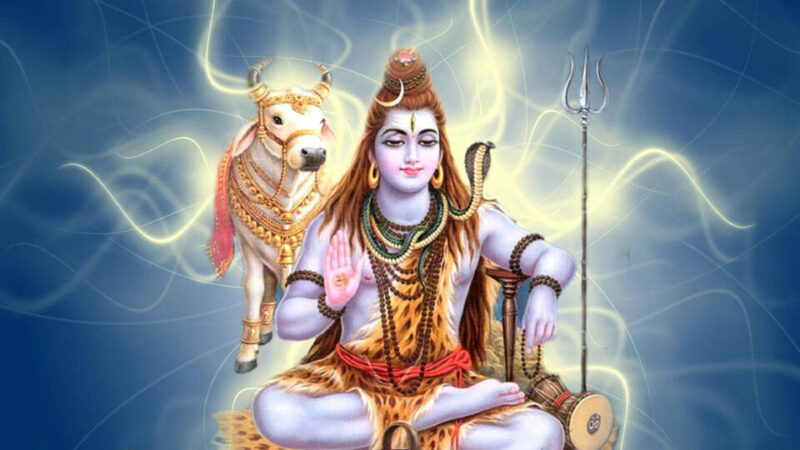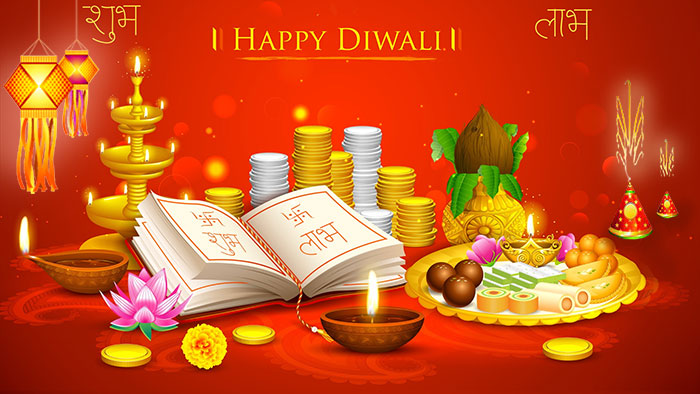Hindu funeral mantras/prayers
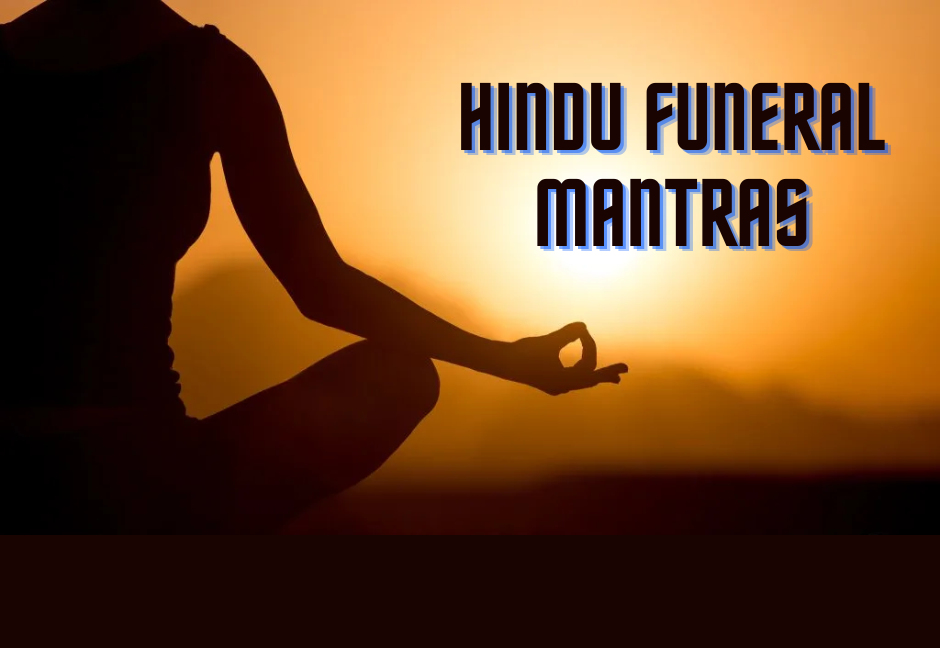
Hindu Funeral Prayers/Hindu funeral Mantras
According to Hindu funeral rituals, Hindu Funeral Prayers & Hindu funeral Mantras are very important in Hindu funerals because it believes that Hindu Funeral Prayers & Hindu funeral Mantras help to give peace to the soul. When Hindus are dying, they strive to attain the greatest state of consciousness possible. The family recites Hindu funeral mantras and Hindu funeral prayers according to Hindu funeral rituals, while they focus on the top of the deceased’s head. Additionally, they frequently use a mala, which is a string of beads intended to keep them focused on their Hindu funeral prayers.
Chanting Hindu funeral mantras plays a big role in the Hindu faith, as they are thought to help you release positive energy, experience divine consciousness, and reach eternal peace. Because Hindu funeral mantras can provide serenity and comfort, Hindu funeral attendees often chant them.
Here are some Hindu funeral mantras which you can chant at a Hindu funeral to give peace to the soul.
Hindu funeral mantras :
1) Hindu funeral shiva Gayatri mantras (Hindu funeral mantras) :
ॐ महादेवाय विद्महे रुद्रमूर्तये धीमहि
तन्नः शिवः प्रचोदयात्॥
Om Mahadevaya Vidmahe ,
Rudramurtaye Dhimahi,
Tannah Shivah Prachodayat॥
Benefits of Shiva Gayatri Mantra :
Regular chanting of Shiva Gayatri Mantra as a Hindu funeral mantra gives peace of mind and keeps away all the evil from your life and makes you healthy, wealthy, and prosperous. Hindu funeral mantras give peace to the soul.
How to chant Shiva Gayatri Mantra/ Hindu funeral mantras :
To get the best result you should chant Shiva Gayatri Mantra early morning after taking bath and in front of God Shiva Idol or picture as a Hindu funeral mantras. You should first understand the Shiva Gayatri Mantra meaning in Hindi to maximize its effect.
These are very powerful Hindu funeral mantras that help you ask for forgiveness from Lord Shiva for any sin that you may have done along the course of your life. This extremely powerful Hindu funeral mantra/ Hindu funeral mantras helps us escape the fear of death.
Traditionally In Hindu funeral rituals all Hindus, with the exception of children, and saints are cremated, this is due to the Hindu belief that it is the fastest way for the soul to escape and be free from the tethers of the soul’s old body.
2) Hindu funeral mantras as a Hindu funeral prayer:
In Hindu funeral prayers, Hindu funeral Mantras:
||Om Namah Shivay ||
or you can chant Hindu funeral Mantras also this one
||Shivay Namah|| as Hindu funeral mantras.
Hindu funeral rituals take the form of chants Hindu funeral mantras as Hindu funeral prayers, which are specially written to be chanted at Hindu funerals. In Hindu funeral rituals, Hindu funeral mantras play an important role, Those who worship Lord Siva recite ‘Om Nama Sivayah,’ and also ‘Sivaya Namaha, These are our Hindu funeral mantras. ‘ These Hindu funeral Mantras are the most powerful Hindu funeral Mantras as Moksha God is Shiva’ (Mahadev). and these Hindu funeral mantras are God Shiva’s, this Hindu funeral mantras help a lot to give soul peace. In Hindu funerals and Hindu funeral rituals, Hindu funeral mantras As Hindu funeral prayers help to give moksha to the soul.
you can chant these Hindu funeral mantras in Hindu funeral prayers 108 times. According to Hindu funeral rituals, Hindu funeral mantras are given the soul peace.
According to Hindu funeral prayers In Hindu funeral mantras, The first is called Sthula Panchakshara and the second is called Sookshma Panchakshara.
Each of the letters in these Hindu funeral mantras has significance in Hindu funeral prayers for Hindu funeral mantras.
‘Na’ represents our pride.
‘Ma’ represents the impurities in our minds.
‘Si’ represents Lord Siva.
‘Va’ represents Goddess Sakti.
‘Ya’ represents the atma.
So when we say, ‘Sivaya Namaha,’ the atma, represented by ‘ya,’ is in the middle.
so in Hindu funeral prayers Hindu funeral mantras On one side are pride and other impure thoughts represented respectively by ‘Na,’ and ‘Ma.’ On the other side of ‘ya,’ we have Lord Siva and Goddess Sakti represented by ‘Si’ and ‘Va.’
So it is for us to decide what we are going to do. Will we go the way in which temptation leads us? Or will we turn towards God? The ‘ya’ comes right next to ‘Va,’ for the Goddess is even more merciful than Lord Siva. After all, an erring child is afraid to approach its father. It first seeks forgiveness from its mother, who recommends to the father that he must not judge his child harshly.
In the same way, the Goddess makes sure that the Lord’s wrath is not directed toward us. She speaks to Him on our behalf. To get His mercy, we must go to Her first. His mercy then automatically comes to us.
or you can chant these Hindu funeral mantras also, The Hindu funeral mantra for the dying is Om Namo Narayana’ya. This is a Hindu funeral mantra that brings peace to the person on the way back to God and to those grieving. The Vaishnava tradition is for the grieving to chant the Hindu funeral mantras for 10 days and then perform the shraddah ceremony.
3) In Hindu funeral rituals there is the easiest Hindu funeral mantra is the
“OM”
The one universally recommended is Om (ॐ). ॐ (oṃ) = OM is a sacred sound and a spiritual symbol in Indian religions as a Hindu funeral prayer.
It is one of the most powerful Hindu funeral mantras.
These Hindu funeral mantras will help heal you, awaken you spiritually (bring enlightenment), minimize your negative karma in your present or future, and manifest the deep desires of your heart.
There are 3 ways to say them.
• Out loud with voice
• Whisper
• In your heart (mind). This is the most powerful way to do it.
4) In Hindu funeral According to Hindu funeral rituals the other Hindu funeral mantras is
|| Om Namo Narayanaya ||
The Hindu funeral mantra for the dying is Om Namo Narayana’ya. This is a mantra that brings peace to the person on the way back to God and to those grieving. At a Hindu funeral, The Vaishnava tradition is for the grieving to chant that mantra for 10 days and then perform the shraddha ceremony.
Let us bow to the divine.
At a Hindu funeral, attendees may chant the mantra, “Om Namo Narayanaya,” which more specifically translates to “I bow to Lord Narayana.” Lord Narayana is the Supreme God.
Chanting this phrase helps give comfort to those grieving and peace to the deceased. In fact, the word “Narayanaya” represents the final resting place for those who pass away.
5) Mahamrityunjaya mantra
The Mahamrityunjaya mantra is for avoiding accidents and death as a Hindu funeral mantra. Mahamrutyunjaya mantra is also known as a Hindu funeral mantra, If people chant these Hindu funeral mantras while the person is really dying, it pulls on their soul and keeps them here, which can be painful for them.
It unification of three hindi words,
Maha- great,
Mrityun- death and Jaya- victory; the one who victor the death.
According to Hinduism, the Hindu funeral mantra is also referred to as the Mrita-Sanjivini mantra because of its “life-restoring” practice.
||ॐ त्र्यम्बकं यजामहे सुगन्धिं पुष्टिवर्धनम्
उर्वारुकमिव बन्धनान्मृत्योर्मुक्षीय माऽमृतात् ||
||Om tryambakaṃ yajāmahe sugandhiṃ puṣṭivardhanam
urvārukamiva bandhanānmṛtyormukṣīya mā’mṛtāt ||
“We worship the three-eyed Lord who is fragrant
and who nourishes and nurtures all beings.
Like the pumpkin, I am bound.
Liberate me from death for immortality.”
6) Garuda Gayatri Mantra
- Tatpurushaaya vidmahe suvarnapakshaaya dheemahi |
Tannoe garudah prachoedayaat ||
we meditate upon that Purusha.
We meditate upon the one who has beautiful colored wings for that purpose. May the Garuda invigorate us in our meditation to Purusha.
Shaanti Mantraah ( Mantras Praying For Peace)
- Vidhartaara(ga)m havaamahe vasoeh kuvidwaanaati nah |
Savitaaram nri-chakshasam ||
We invoke the Lord, the creator of the Universe. He is a unique supporter of the Universe. He is the one who endows us with knowledge. May that Lord grant us prosperity!
- Adyaa noe deva savitah prajaavat saavees-saubhagam |
Paraa dush-vapinya(ga)m suva ||
Oh resplendent Lord Savitar! You have blessed us with prosperity in the form of off-springs. Please help us discard the fear caused by bad dreams.
- Madhu vaataa ritaayate madhu ksharanti sindhavah |
maadhveer-nassantva-oeshadeeh ||
May the winds blow and rain shower bliss on me who is anxious to reach Paramaatman! May the oceans likewise be kind to me! May plants and herbs also be kind to me!
- Madhu naktam-utoshaci madhumat paarthiva(ga)m rajah |
madhu dyaur-astu nah pitaa ||
May all things bring pleasantness to me both during day and night! May all elements on earth be sweet to me! May the heavens, the abode of my ancestors (Pitrus) bring always a joy to me!
- Madhumaannoe vanspatir madhumaa(ga)m astu sooryah |
Maadhveer gaavoe bhavantu nah ||
May plants and trees be sweet to us! May the Lord Soorya (Sun God) be always pleasant to us! May the cows be sweet to us!
- Viswaani deva savitar duritaani paraasuva |
Yad bhadram tanma aasuva ||
Oh Resplendent Lord Savitar! You are the cause of the Universe; please destroy all our sins. Please grant us that which is good (for we even do not know what is good to us)!
These mantras are chanted seeking peace from external and atmospheric and natural disturbances that uproot our lives while conducting fire sacrifices (yajnas) for peace. This is a famous mantra chanted often.
7) Mrityunivaarana Mantraah (Mantras For Avoiding Death)
- Apaitu mrityur-amritam na aagan-vaivasvato noe abhayam krinotu |
parnam vanaspate rivaabhinas-seeyataa(Ga)m rayi s-sachataannas-sacheepatih ||
May Death turn away from us! May Immortality come to us! May Vaivasvata divinity Yama grant us safety! May our sins be destroyed like leaves that are separated from trees! May the imparting wealth come to us!
- Param mrityo anuparehi panthaam yaste sva itaro devayaanaat |
chakshushmate srinvate te braveemi maaa nah prajaa(ga)m reerisho mota veeraan ||
OH, Death! Go back by your own path which is different from that of God. I entreat you as one who is capable of seeing me and listening to me. Do not destroy our progeny. Do not strike down our Heroes.
- Vaatam praanam manasaa anvaa-rabhaamahe prajaapatim yo bhuvanasya gopaah |
Sa no mrityos-traayataam paatva(ga)mhaso jyogjeevaa jaraam-aseemahi ||
We heartily supplicate to the Lord of Beings who is the protector of the Universe and who is active within us Vital-breath and outside us as the Blowing Wind. May he guard us against death and protect us from sin. May we live gloriously in our old age.
- Amutra bhooyaa dadha yadyamasya brihaspate abhisasteramunchah |
pratyauhataam-asvinaa mrityu –masmaa-ddevaanaa-magne bhishajaa sacheebhih ||
Oh Supreme Lord! Release me from the fear of Yama and accusation of people and the necessity of being in the yonder world. Oh Agni! May the two divine physicians, The Asvins, chase away from our death by virtue of the merits of religious dedication.
- Hari haranta-manuyanti devaa visvasyesaanam vrishabham mateenaam |
Brahma saroopa-manumeda-maagaa-dayanam maa vivadheer-vikramasva ||
Like attendants, all gods (divine) follow Hari who is the Lord of the Universe, who leads all thoughts as the foremost leader, and who absorbs into the Universe at the time of dissolution. May this path to liberation taught in Vedas having the same form as Brahman open itself unto me! Do not deprive me of that! Strive to secure it for me!
- Salkair-agni-mindhaana ubahau lokau sanemaham |
Ubhayor-lokayor ridhvaa-ati mrityu taraamyaham ||
Kindling the consecrated fire with fagots of wood in order to perform fire sacrifice may I attain both the worlds. Having attained this world and the next (Bhooloka and pitruloka) I shall cross over death.
- Maa cchido Mrityo maa vadhhermaa mae balam vivriho maa pramosheeh |
Prajaam maa mae reerisha aayurugra nrichakshasam tvaa havishaa vidhema ||
Oh, Fierce Death! Do not cut off my life! Do not harm my interests. Do not cripple my strength, Do not subject me to deprivation. Do not hurt my progeny and life. I shall serve you with oblations; for, you are ever vigilant over deeds of men.
- Maa noe mahaantamuta maa noe arbhakam maa na ukshantamuta maa na ukshitam |
Maa noe vdheeeh pitaram moeta maataram priyaa maa nastanuvo rudra reerishah ||
- Maa nastoke tanaye maa na aayushi maa noe goshu maa noe asveshu reerishah |
Veeraanmaa noe rudra bhaamito vadheer-havishmanto namasaa vidhema tae ||
Oh, Rudra! Injure not our elders, our children, our adults capable of procreation, the fetus we have laid in the mother’s womb, and our father and mother. Do not hurt our dear selves!
The repetition of the same them in these mantras makes the passage a vivid record of deep feeling and reminds us of the most r famous Rigveda Mantra Mrityor maa Amritam Gamaya leads us from Death to Immortality
What is a mantra and how does it work?
Mantras are powerful sounds. Mantras are the sounds that when chanted produce great effects. These are chanted repeatedly and that is called Japa. Japa is a key part of Hindu prayer.
Mantras are very rich in their meaning. While doing Japa one can meditate on the mantra and its meaning. As the mind dwells more and more into that meaning, the mantra conditions the mind and takes it up to higher states, and forms the path to the great liberation – eternal bliss.
What makes Hindu funeral mantras so special as compared to normal words?
Hindu funeral Mantras are not composed by humans. One may wonder how can that be possible. Especially given that there are sages associated with the mantras. The point to be noted is that these sages are not composers of these mantras, as we would normally compose sentences. They are not the inventors, but they are the discoverers of the mantra. They get to know the mantras in a state in which these words do not emanate from their thoughts, but they are just passive audience to it. Those who go deep in meditation and realize God may be able to get a feel of this situation.
To be such a discoverer, even though they are just passive hearers, needs a great amount of qualification. Only the perfect one can unchangingly reproduce the mantra he has heard. The only one that is absolutely perfect is God. All other discoverers reproduce that mantra only as pure as their closeness to perfection.
Veda Samhitas are full of mantras and hence have been preserved for ages in their pure form by utilizing the various techniques like path, krama, jaTa, and Gana pATas, that ensure that the chanter clearly gets the correct letters and even the correct level of sound for each letter (svara). The chanters are advised to chant the mantras only after getting the right pronunciation of them so that the mantras are preserved against deterioration over time. There would be gurus who initiate the disciple in a mantra. The guru ensures that the disciple got the mantra right so that the person can chant independently as well as initiate others in that mantra. Ensuring this preservation, the Vedas were passed on only through the tradition of guru and disciples and were never written down till the very recent past. (It is really amazing to note that without being written down the Vedas have been preserved in pure form across the land by these techniques. Though the texts are freely available now for anybody to read, it would be important to ensure that these mantras are properly learned and then chanted. This way the treasure that has been preserved so carefully over multiple millenniums does not deteriorate due to indifference.)
It is to be noted that many of the hymns of ThirumuRai are known to have the great powers of mantras that are practiced even today.
While there are plenty of mantras available, there are a few that are chanted with high esteem by the Shaivas. Definitely, those are highly powerful ones that can lead the chanter on the great path to Mukti (liberation). Pranava, paNJchAkashra, and Gayatri to name a few. For Shaivites, the Holy Five Syllables (paNJchAkshara) with or without the combination of the Pranava is the ultimate mantra.
- Mantras are energy-based sounds.
Saying any word produces an actual physical vibration. Over time, if we know what the effect of that vibration is, then the word may come to have meaning associated with the effect of saying that vibration or word. This is one level of energy basis for words.
Another level is intent. If the actual physical vibration is coupled with a mental intention, the vibration then contains an additional mental component that influences the result of saying it. The sound is the carrier wave and the intent is overlaid upon the wave form, just as a colored gel influences the appearance and effect of white light.
In either instance, the word is based upon energy. Nowhere is this idea more true than for the Sanskrit mantra. For although there is a general meaning which comes to be associated with mantras, the only lasting definition is the result or effect of saying the mantra.
- Mantras are tools of power and tools for power.
They are formidable. They are ancient. They work. The word “mantra” is derived from two Sanskrit words. The first is “manas” or “mind,” which provides the “man” syllable. The second syllable is drawn from the Sanskrit word “trai” meaning “protect” or “free from.” Therefore, the word mantra in its most literal sense means “to free from the mind.” Mantra is, at its core, a tool used by the mind which eventually frees one from the vagaries of the mind.
But the journey from mantra to freedom is a wondrous one. The mind expands, deepens, and widens, and eventually dips into the essence of cosmic existence. On its journey, the mind comes to understand much about the essence of the vibration of things. And knowledge, as we all know, is power. In the case of mantra, this power is tangible and wieldable.
- Mantra energizes prana.
“Prana” is a Sanskrit term for a form of life energy that can be transferred from individual to individual. Prana may or may not produce an instant dramatic effect upon transfer. There can be heat or coolness as a result of the transfer.
Some healers operate through the transfer of prana. A massage therapist can transfer prana with a beneficial effect. Even self-healing can be accomplished by concentrating prana in certain organs, the result of which can be a clearing of the difficulty or condition. For instance, by saying a certain mantra while visualizing an internal organ bathed in light, the specific power of the mantra can become concentrated there with great beneficial effect.
- Mantras eventually quiet the mind.
At a deep level, the subconscious mind is a collective consciousness of all the forms of primitive consciousnesses which exist throughout the physical and subtle bodies. The dedicated use of mantra can dig into subconscious crystallized thoughts stored in the organs and glands and transform these bodily parts into repositories of peace.
Some of you may be interested or even fascinated by the discipline of Hindu funeral mantras, but feel somewhat overwhelmed by the array of mantras and disciplines, autostarts, and pujas you find here. If so, then this chapter will be of use to you. It contains some simple mantras and their common application. They have been compiled from Vedas and Upanishads, drawn from the various headings of the deities or principles involved. These mantras address various life issues which we all face from time to time.
According to the Shrimad Bhagwad Geeta, the soul never dies, only the bodies die. Then what does death mean? Is there any Shloka or Stotram explaining death?
Lord Krishna gives a very clear definition about death in Bhagavad Gita 2.22:
vāsāṁsi jīrṇāni yathā vihāya
navāni gṛhṇāti naro ’parāṇi
tathā śarīrāṇi vihāya jīrṇāny
anyāni saṁyāti navāni dehī
Translation:
As a person puts on new garments, giving up old ones, the soul similarly accepts new material bodies, giving up the old and useless ones.
Krishna also mentions that death is a very natural process and a sane person is not bewildered by it (BG 2.13):
dehino ’smin yathā dehe
kaumāraṁ yauvanaṁ jarā
tathā dehāntara-prāptir
dhīras tatra na muhyati
Translation:
As the embodied soul continuously passes, in this body, from boyhood to youth to old age, the soul similarly passes into another body at death. A sober person is not bewildered by such a change.
Then Krishna also reveals that death is certain for all living entities who have accepted a material body and it is no cause for lamentation (BG 2.27):
jātasya hi dhruvo mṛtyur
dhruvaṁ janma mṛtasya ca
tasmād aparihārye ’rthe
na tvaṁ śocitum arhasi
Translation:
One who has taken his birth is sure to die, and after death one is sure to take birth again. Therefore, in the unavoidable discharge of your duty, you should not lament.
Krishna reveals the art of dying in the 8th chapter, where he mentions that whatever state of being a person remembers at the time of death, that state he achieves for sure:
Bg 8.6 — Whatever state of being one remembers when he quits his body, O son of Kuntī, that state he will attain without fail.
Therefore Krishna suggests that one should remember Krishna at the time of death so that he can return to the eternal spiritual world and live happily with Krishna:
Bg 8.5 — And whoever, at the end of his life, quits his body remembering Me alone at once attains My nature. Of this, there is no doubt.
But, it is not easy for a normal person to remember Krishna at the time of death because the soul is in a troubled condition at the time of leaving the body, therefore Krishna suggests that one should practice throughout his life so that one can think of Krishna at the time of death. And how we practice is explained in BG 8.7. Here Krishna very clearly says tasmat sarvesu kalesu – therefore at all times, mām anusmara – one should remember me (Krishna). And to remember Krishna at all times, one must offer his mind and intelligence to Krishna – mayy Arpita-mano-buddhir. Here is the exact verse (Bg 8.7) and the purport from Srila Prabhupada:
tasmāt sarveṣu kāleṣu
mām anusmara yudhya ca
mayy arpita-mano-buddhir
mām evaiṣyasy asaṁśayaḥ
Translation:
Therefore, Arjuna, you should always think of Me in the form of Kṛṣṇa and at the same time carry out your prescribed duty of fighting. With your activities dedicated to Me and your mind and intelligence fixed on Me, you will attain Me without a doubt.
This instruction to Arjuna is very important for all men engaged in material activities. The Lord does not say that one should give up his prescribed duties or engagements. One can continue them and at the same time think of Kṛṣṇa by chanting Hare Kṛṣṇa. This will free one from material contamination and engage the mind and intelligence in Kṛṣṇa. By chanting Kṛṣṇa’s names, one will be transferred to the supreme planet, Kṛṣṇaloka, without a doubt.
Srila Prabhupada also explains this point very clearly in the “Introduction” to Bhagavad Gita As It Is. Here is an excerpt from the Introduction:
We work not with our body, actually, but with our mind and intelligence. So if the intelligence and the mind are always engaged in the thought of the Supreme Lord, then naturally the senses are also engaged in His service. Superficially, at least, the activities of the senses remain the same, but the consciousness is changed. The Bhagavad-gītā teaches one how to absorb the mind and intelligence in the thought of the Lord. Such absorption will enable one to transfer himself to the kingdom of the Lord. If the mind is engaged in Kṛṣṇa’s a service, then the senses are automatically engaged in His service. This is the art, and this is also the secret of Bhagavad-gītā: total absorption in the thought of Śrī Kṛṣṇa.




